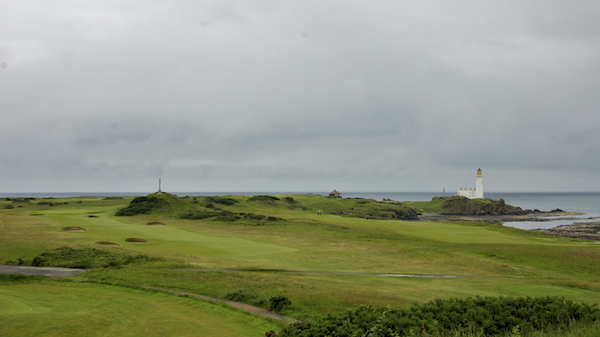Dear Sports Fan,
What does “links” mean in golf?
Thanks,
Wade
Dear Wade,
The term, “links” has two meanings within golf. It is used generally to refer to the course that golf is played on. A golfer might say to a friend of hers, “sorry, I can’t come over and collect kindling with you because I’m going to hit the links today. It also has a more technical meaning, referring to a particular type or style of golf course. If you haven’t ever bothered to dig into the history of the word links, you might find it easy to invent reasons for its general meaning. Viewed from above, a golf course, with its many kidney shaped fairways and greens, can look a little like a string of sausages. Perhaps that’s why it’s described as links? If you’ve never seen it written, you might think that it’s not “links” but “lynx,” the genus of small, predatory, wild cats. Why a cat? Who knows? Half of golf terms seem to be birds, so why not throw a cat in there? In truth, the history of the use of the word “links” in golf can be traced all the way back to the very beginning of the sport.
Although the very first golf-like games may have been played in what is now the Netherlands as early as 1261, golf historians tend to trace a direct line from Scotland in the 1400s to today. Golf must have been a fairly common sport by the mid-1400s and just as addictive as its modern counterpart, because in 1457 it was officially prohibited by the King of Scotland. Early golf enthusiasts faced several difficulties. As we already know, golf was outlawed at times, but even when it was legal, you needed a lot of uninhabited, non-farm land to play it on. The solution that many Scottish golfers found was to create courses near the shore, where the earth was sandy and the water brackish. Useless for farming, this land was ideal for the sport in many ways. The grasses that grew tended “to have short blades with long roots,” which made it hearty enough to survive being hit with clubs and balls, and when nibbled short by livestock, smooth enough for the ball to run on. The hard ground also encouraged the ball to bounce and roll further. The landscape also came with many natural impediments to golf – wind and rain blowing in from the sea, small streams that ran through the land and sandier patches that stopped the grass from growing and the ball from rolling. Instead of resisting these features, golfers embraced the challenge, and indeed, water hazards and sand traps are the two main artificially created obstacles on modern golf courses. The word the Scots used to describe this environment was “links” which comes from the Old English, hlinc, meaning “rising ground” or “ridge.”
Golf is no longer illegal and there are courses spread around the world in every environment imaginable. Although it can be used as a general term, links has retained its meaning as being descriptive of a certain style of golf course set in a particular type of environment. The most obvious visual difference between a non-links and a links course is that a links course will have few or no trees. Unlike a modern course, where the fairways (a safer area to set up a golfer’s next shot, because it has shorter, more even grass) and the rough (the opposite) are easily visually distinguished by color and texture, on links courses they are more difficult to distinguish. The same goes for the course’s greens which, on modern courses are planted with very soft grass to make the ball slow down and roll, but which on links courses may be more similar to the rest of the course. Water and sand are the key obstacles in all styles of golf course, but on links courses, they are either naturally occurring or carefully designed to give that impression. A key difference on links courses is the presence of some very dramatic walls that hold a green back from a sandy bunker.
As a result of the topographical and environmental differences, success on a links course requires different techniques from other courses. Tina Mickelson addresses this on a post she wrote for the PGA website. She identifies three key differences:
- Because of the wind on links courses, players should drive the ball (the first and usually longest shot on any given hole) with a lower trajectory than on other courses.
- Since the texture of the grass doesn’t vary as much between fairway and green, players should let the ball bounce up and onto the green as opposed to trying to loft it into the air and have it stick on the green.
- The sand bunkers on links courses tend to be much more treacherous than on other courses. Mickelson recommends practicing very high shots out of sand, to get over the walls, and extreme prudence. It’s better to hit the ball the wrong way but onto the grass than it is to get stuck in the sand for shot after shot.
Golf enjoys tradition as much as any sport and as such, there’s a certain prestige to links courses. The downside of this is that lost of golf courses that don’t really fit the description of a links course call themselves one anyway, for marketing reasons. The benefit of golf’s attraction to its own past is that it gives The British Open, the only major tournament always played on a true links course, the enjoyable and rosy glow of long history and tradition.
Thanks for reading,
Ezra Fischer

